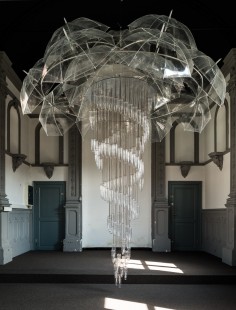Mark Swysen
Garden of Eden

source: markswysen
Mark Swysen reflects on human conduct. Yet the human figure itself mostly remains absent in his work: the artist wishes to incite the visitors imagination.
Mark embraces the basic proposition of conceptual art: “the idea is the most important aspect of the work”. Wishing to mould this idea into an intriguing shape, the artist is constantly in search of the most eloquent visual stimuli. Any material or object can be an instrument in his visual language. He snatches everyday objects out of their usual context and charges them with new layers of meaning. The result of his deconstruction and re-assembling questions the one-dimensionality of our perception and opens new possibilities for interpretation. The emotional load of the surrounding architecture participates in the lecture: hence a manifest preference for “in situ”-projects.
.
.
.
.
.
.
.
source: markswysen
Mark Swysen is born in Hasselt (Belgium), lives and works in Antwerp. He graduated in biological sciences and is a master in art & research. His work focuses on human conduct. He reflects upon what moves man, how he interacts with his peers and intervenes in the world in which he lives. Yet the human figure itself remains conspicuously absent: the artist wishes not to render an image, but to enhance imagination.
visual language
Mark Swysen re-interpretes the basic proposition of conceptual art: “the idea is the most important aspect of the work”. But the sole idea is not sufficient. The shape in which this idea is molded has to attract, to intrigue, to give rise to a query for the content.
The repertoire of materials used is inexhaustible: acryl and mixed media on canvas, burnt wood, lead, steel, bitumen, plastics and polycarbonates, water. Any object can be recycled in his visual language: empty PET-bottles, used clothing or furniture, etc… He de- and reconstructs, manipulates shapes, adds colors, light or sound.
Upon entering the location, the artefact or installation attracts the visitor. With the use of everyday objects in addition to symbols belonging to our collective cultural heritance, the artist intrigues the visitor. The stimulus surpasses the ratio: primitive instincts and subcutaneous emotions play an equal role. The aesthetic experience is meant as an incitement for the visitor in order to question and to discover the work. The artefact takes on new significance by means of the links made by the visitor with human behaviour, philosophy, sciences,…
different angles of interpretation
The work is open to various interpretations from different angles, in multiple layers. Mark Swysen does not put forward dogmas, personal or absolute truths; he opens possible tracks of thinking. The visitor benefits from the total liberty of his personal interpretation – coloured by his private horizon of experiences -, considered by the artist to be as interesting as his own intentions.
The different layers of significance, the intangibility are characteristics of an artist in search of the sublime. As Kant puts it, a sublime work of art grabs at a person’s throat, overwhelms one. Yet you cannot put it into words. Looking from that angle of perspective, it raises little surprise that the work of Mark Swysen is at times perceived as being spiritual and is embraced in ecclesiastical circles without having any religious origin.
in situ work
The architecture surrounding the artefacts – the parergon, dixit Derrida – and the emotional load of the location constitute a major ingredient of the work. They participate in the lecture. Hence Mark Swysen’s manifest preference for “in situ”-projects. Some of his major projects are deliberately situated in a very specific setting. His “Causa Vitae”-project, a reflection on the meaning of life, is exhibited in gothic churches and cathedrals. Fortress Europe, about the migration issue, is shown in historical military fortifications.
.
.
.
.
.
.
.
source: bamartbe
Mark Swysen reflects on human behavior. The artist explores how innate mechanisms interact and steer the human conduct. The human figure itself remains conspicuously absent: the artist wishes to incite the imagination of the visitor. Mark Swysen re-interprets the basic proposition of conceptual art that “the idea is the most important aspect of the work”. Though his artifacts are drafted as an invitation for the viewers brain, the artist constantly seeks for the most eloquent visual stimuli: primitive instincts and subcutaneous emotions interact with the visitor’s personal background. At their best, his installations develop into a physical experience.
Because the shape in which the concept is molded has to give rise to a query for the content, any material, object, sound or symbol belonging to our collective cultural heritage can be recycled in his visual language.
As the architecture surrounding the artefacts constitute a major ingredient in the lecture of the work, Swysen has a manifest preference for “in situ”-projects.
.
.
.
.
.
.
.
source: delaro
Is geboren te Hasselt, woont en werkt in Antwerpen. Inhoudelijk exploreert zijn werk het gedrag van mensen: Op emotioneel en relationeel vlak, en de relaties tussen mensen onderling.
Dit vormt zijn uitgangspunt om ideeën te formuleren over hedendaagse maatschappelijke discussiepunten.
Mark Swysen bracht reeds tentoonstellingen in belangrijke musea, w.o. de Carolus Borromeuskerk (Antwerpen), Campo Santo ( Gent), Fort Napoleon ( Oostende), Het Minderbroedersmuseum ( Sint-Truiden), Het Felix art Museum ( Brussel) en Museum De Fundatie ( Zwolle, Nederland).

